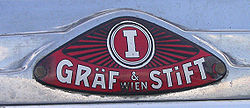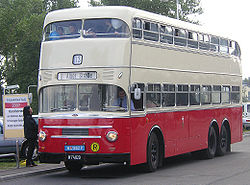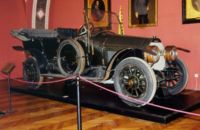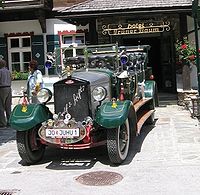
Gräf & Stift
Encyclopedia


Austria
Austria , officially the Republic of Austria , is a landlocked country of roughly 8.4 million people in Central Europe. It is bordered by the Czech Republic and Germany to the north, Slovakia and Hungary to the east, Slovenia and Italy to the south, and Switzerland and Liechtenstein to the...
n manufacturer of automobile
Automobile
An automobile, autocar, motor car or car is a wheeled motor vehicle used for transporting passengers, which also carries its own engine or motor...
s, truck
Truck
A truck or lorry is a motor vehicle designed to transport cargo. Trucks vary greatly in size, power, and configuration, with the smallest being mechanically similar to an automobile...
s, bus
Bus
A bus is a road vehicle designed to carry passengers. Buses can have a capacity as high as 300 passengers. The most common type of bus is the single-decker bus, with larger loads carried by double-decker buses and articulated buses, and smaller loads carried by midibuses and minibuses; coaches are...
es and trolleybus
Trolleybus
A trolleybus is an electric bus that draws its electricity from overhead wires using spring-loaded trolley poles. Two wires and poles are required to complete the electrical circuit...
es, from 1902 until 2001, latterly as a subsidiary of MAN. Founded in 1902 by the brothers Franz, Heinrich and Karl Gräf, and the investor, Wilhelm Stift. Before the Second World War
World War II
World War II, or the Second World War , was a global conflict lasting from 1939 to 1945, involving most of the world's nations—including all of the great powers—eventually forming two opposing military alliances: the Allies and the Axis...
, the company was a well-known manufacturer of luxury automobiles, including the one that famously took part in the Assassination of Archduke Franz Ferdinand. By the 1930s Gräf & Stift had begun making trucks and buses, and it ceased car manufacturing in 1938. The company merged with Österreichische Automobil Fabriks-AG
ÖAF
ÖAF is an initialism for Österreichische Automobil-Fabrik, previously known as Österreichische Austro-Fiat, an Austrian car and truck manufacturer.-Austro-Fiat:...
(ÖAF) in 1971, becoming ÖAF-Gräf & Stift AG, and later the same year was taken over by MAN AG. It continued in business as a subsidiary
Subsidiary
A subsidiary company, subsidiary, or daughter company is a company that is completely or partly owned and wholly controlled by another company that owns more than half of the subsidiary's stock. The subsidiary can be a company, corporation, or limited liability company. In some cases it is a...
of MAN, and the Gräf & Stift name remained in use as an MAN brand
Brand
The American Marketing Association defines a brand as a "Name, term, design, symbol, or any other feature that identifies one seller's good or service as distinct from those of other sellers."...
for the Austrian market and for trolleybuses until 2001, when ÖAF-Gräf & Stift AG was renamed MAN Sonderfahrzeuge AG. It was located in Vienna
Vienna
Vienna is the capital and largest city of the Republic of Austria and one of the nine states of Austria. Vienna is Austria's primary city, with a population of about 1.723 million , and is by far the largest city in Austria, as well as its cultural, economic, and political centre...
, and the production facilities continue in use there, but no longer using the Gräf & Stift name.
The beginnings
The Gräf brothers started a bicycleBicycle
A bicycle, also known as a bike, pushbike or cycle, is a human-powered, pedal-driven, single-track vehicle, having two wheels attached to a frame, one behind the other. A person who rides a bicycle is called a cyclist, or bicyclist....
service workshop in Vienna
Vienna
Vienna is the capital and largest city of the Republic of Austria and one of the nine states of Austria. Vienna is Austria's primary city, with a population of about 1.723 million , and is by far the largest city in Austria, as well as its cultural, economic, and political centre...
in 1893, quickly branching out into bicycle manufacturing. Their bicycles sold well, requiring the company to relocate to be able to increase capacity. While the bicycle business in Europe was booming, the brothers also saw potential in the fledgling automobile
Automobile
An automobile, autocar, motor car or car is a wheeled motor vehicle used for transporting passengers, which also carries its own engine or motor...
, and commissioned Josef Kainz to design one. The result was an unusual voiturette
Voiturette
Voiturette is a word mostly used to describe a miniature automobile; however, it has several nuanced meanings, depending largely on the usage date.-History:...
with by a one-cylinder De Dion-Bouton
De Dion-Bouton
De Dion-Bouton was a French automobile manufacturer and railcar manufacturer operating from 1883 to 1932. The company was founded by the Marquis Jules-Albert de Dion, Georges Bouton and his brother-in-law Charles Trépardoux....
engine fitted in front of the vehicle, powering the front axle, built sometime between 1895 and 1898, according to various sources. It was thus arguably the world's first front-wheel drive
Front-wheel drive
Front-wheel drive is a form of engine/transmission layout used in motor vehicles, where the engine drives the front wheels only. Most modern front-wheel drive vehicles feature a transverse engine, rather than the conventional longitudinal engine arrangement generally found in rear-wheel drive and...
automobile, but it never saw mass production, with only one copy ever made, even though the technology was eventually patented in 1900. However, the voiturette remained in regular use until 1914 and was in working condition yet at the dawn of the 1970s.
Partnership with Willy Stift
In 1901, the brothers started cooperating with the Austrian businessman Wilhelm (Willy) Stift, an automobile importer who had already ventured into automobile manufacturing under the marque CeleritasCeleritas
Celeritas is a Latin word, translated as "swiftness" or "speed". It is often given as the origin of the symbol c, the universal notation for the speed of light in a vacuum, as popularized in Albert Einstein's famous equation E = mc². In SI units, the speed of light in a vacuum is defined as...
. Celeritas automobiles were then assembled using French engines at the Gräf workshops, and in 1904 the gentlemen founded a joint company, named Gräf & Stift. Later, the company manufactured automobiles for the Spitz brand, owned by the automobile vendor Arnold Spitz. When Spitz went bankrupt in 1907, Gräf & Stift started building automobiles under their own brand.
The company concentrated on large, sophisticated and luxurious cars, which became popular with the Austrian aristocracy
Aristocracy
Aristocracy , is a form of government in which a few elite citizens rule. The term derives from the Greek aristokratia, meaning "rule of the best". In origin in Ancient Greece, it was conceived of as rule by the best qualified citizens, and contrasted with monarchy...
and even the Habsburg
Habsburg
The House of Habsburg , also found as Hapsburg, and also known as House of Austria is one of the most important royal houses of Europe and is best known for being an origin of all of the formally elected Holy Roman Emperors between 1438 and 1740, as well as rulers of the Austrian Empire and...
royal family. Apart from luxury cars, Gräf & Stift also became an important manufacturer of bus
Bus
A bus is a road vehicle designed to carry passengers. Buses can have a capacity as high as 300 passengers. The most common type of bus is the single-decker bus, with larger loads carried by double-decker buses and articulated buses, and smaller loads carried by midibuses and minibuses; coaches are...
es as well as tram
Tram
A tram is a passenger rail vehicle which runs on tracks along public urban streets and also sometimes on separate rights of way. It may also run between cities and/or towns , and/or partially grade separated even in the cities...
bodies.
Assassination in Sarajevo

One of the Gräf & Stift luxury limousines, a Double Phaeton (engine no. 287), was bought by Count Franz von Harrach on 15 December 1910. Harrach's car was fitted with a four-cylinder engine delivering 32 PS. In 1914 in Sarajevo, the Archduke Franz Ferdinand of Austria
Archduke Franz Ferdinand of Austria
Franz Ferdinand was an Archduke of Austria-Este, Austro-Hungarian and Royal Prince of Hungary and of Bohemia, and from 1889 until his death, heir presumptive to the Austro-Hungarian throne. His assassination in Sarajevo precipitated Austria-Hungary's declaration of war against Serbia...
and his wife rode together with Harrach in this car, when Gavrilo Princip
Gavrilo Princip
Gavrilo Princip was the Bosnian Serb who assassinated Archduke Franz Ferdinand of Austria and his wife, Sophie, Duchess of Hohenberg, in Sarajevo on 28 June 1914...
assassinated the Archduke. The assassination provoked a series of diplomatic manoeuvres that quickly led to declarations of war and the onset of the First World War.
Between the wars

To acquire necessary volume to assure the profitability of carmaking business, Gräf & Stift also launched smaller models, badged G 35, G 36 and G 8, powered by a 4.6-litre eight-cylinder engine. To cater for lower segments of the market, the company entered an agreement with Citroën
Citroën
Citroën is a major French automobile manufacturer, part of the PSA Peugeot Citroën group.Founded in 1919 by French industrialist André-Gustave Citroën , Citroën was the first mass-production car company outside the USA and pioneered the modern concept of creating a sales and services network that...
, assembling one of the French automaker's models as the MF 6 in 1935-36 (it had a 2.65-litre six-cylinder engine, with Gräf & Stift having had ceased the manufacturing of their own six-cylinders in 1935). Later, a joint-venture was started with Ford of Cologne
Ford Germany
-Ford Motor Co. AG:Until 27 January 1950 all Ford's European operations other than in the USSR were run from Dagenham and owned by Ford Motor Company Limited, Dearborn's 55% owned subsidiary...
, which provided for eight-cylinder Ford-licensed vehicles, badged Gräf-Ford V8, to be assembled by Gräf & Stift.
Neither of those ventures proved successful enough to assure the profitability of the passenger car business of Gräf & Stift, so the company decided to pull out of it. Its last own model was the rather modern C 12, fitted with a new twelve-cylinder engine, which was only made in very limited numbers in 1938, when the company ceased automobile production to concentrate on truck and bus manufacturing.
After World War II
Gräf & Stift remained in the truck and bus manufacturing business after 1945, continuing as a family-owned enterprise, being run by members of the Gräf family. The company built its first trolleybusTrolleybus
A trolleybus is an electric bus that draws its electricity from overhead wires using spring-loaded trolley poles. Two wires and poles are required to complete the electrical circuit...
es in 1948.
MAN subsidiary
In 1971 the company merged with Österreichische Automobil Fabriks-AGÖAF
ÖAF is an initialism for Österreichische Automobil-Fabrik, previously known as Österreichische Austro-Fiat, an Austrian car and truck manufacturer.-Austro-Fiat:...
(ÖAF) to form ÖAF-Gräf & Stift AG, which in turn was taken over by MAN AG the same year. ÖAF-Gräf & Stift AG continued manufacturing under that name, as a subsidiary
Subsidiary
A subsidiary company, subsidiary, or daughter company is a company that is completely or partly owned and wholly controlled by another company that owns more than half of the subsidiary's stock. The subsidiary can be a company, corporation, or limited liability company. In some cases it is a...
of MAN. Still based in Vienna, it was focused on supplying trucks and buses for the Austrian market, mostly based on MAN designs, and additionally specialised in trolleybus
Trolleybus
A trolleybus is an electric bus that draws its electricity from overhead wires using spring-loaded trolley poles. Two wires and poles are required to complete the electrical circuit...
es. It was MAN's main trolleybus producer in the 1980s and 1990s, and these were sold under the Gräf & Stift name, with trolleybuses' being supplied to several European cities, including Salzburg
Salzburg
-Population development:In 1935, the population significantly increased when Salzburg absorbed adjacent municipalities. After World War II, numerous refugees found a new home in the city. New residential space was created for American soldiers of the postwar Occupation, and could be used for...
, Solingen
Solingen
Solingen is a city in North Rhine-Westphalia, Germany. It is located on the northern edge of the region called Bergisches Land, south of the Ruhr area, and with a 2009 population of 161,366 is the second largest city in the Bergisches Land...
and Bergen
Bergen
Bergen is the second largest city in Norway with a population of as of , . Bergen is the administrative centre of Hordaland county. Greater Bergen or Bergen Metropolitan Area as defined by Statistics Norway, has a population of as of , ....
(Norway), among others.
As of 31 December 2000, ÖAF-Gräf & Stift AG had 897 employees, and its sales for the six-month period from 1 July 2000 through 31 December 2000 (the company's "Short Fiscal Year 2000") totalled €111 million.
Use of the longstanding Gräf & Stift name ended in 2001, when MAN renamed the company MAN Sonderfahrzeuge AG, as part of reorganizations following its June 2001 acquisition of Neoplan
Neoplan
NEOPLAN Bus GmbH is a German automotive company that manufactures buses, trolleybuses and coaches. NEOPLAN is now a subsidiary of NEOMAN Bus GmbH, which itself is a part of MAN SE.-Foundations:...
. This in turn became MAN Nutzfahrzeuge Österreich AG in 2004. In that year, MAN built a new plant on Gräf & Stift's original site in the Liesing
Liesing
Liesing is the 23rd district of Vienna . It is on the southwest edge of Vienna, Austria.It was formed after Austria's Anschluss with Germany, when Vienna expanded from 21 districts to 26...
district of Vienna
Vienna
Vienna is the capital and largest city of the Republic of Austria and one of the nine states of Austria. Vienna is Austria's primary city, with a population of about 1.723 million , and is by far the largest city in Austria, as well as its cultural, economic, and political centre...
and continues to be the biggest employer in the area.

